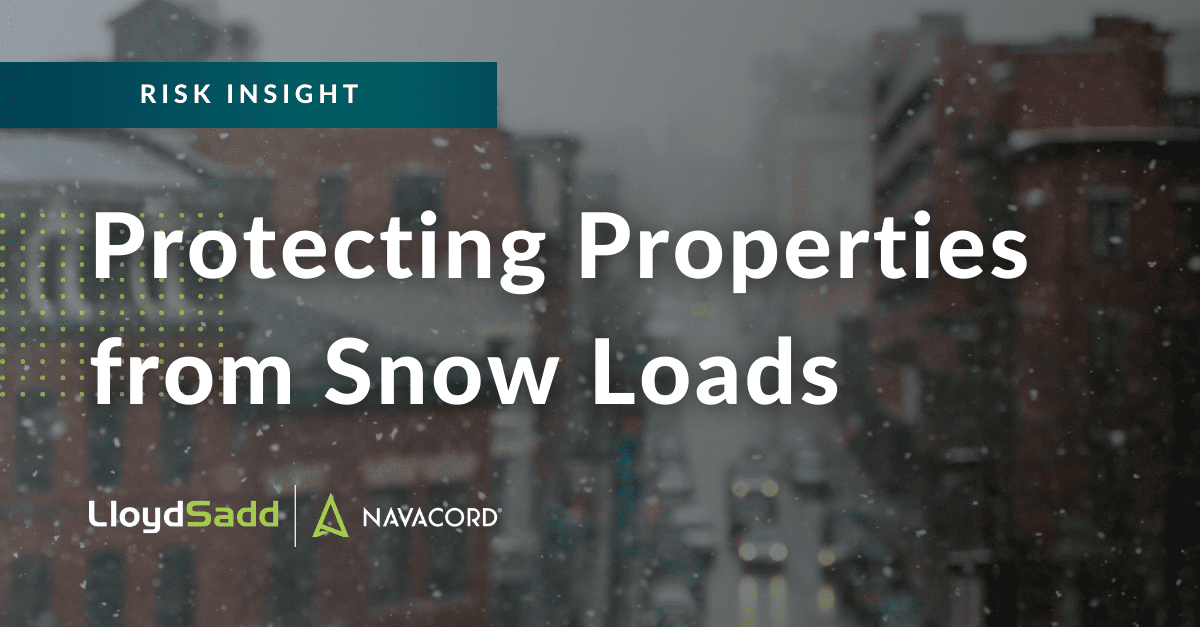Protecting Properties from Snow Loads
Major snow events can impact the integrity of a structure, making it imperative for commercial property owners to understand their building’s characteristics and structural system prior to the start of the snow season. Having familiarity with the building structure can help owners determine if any changes occurred during a major snow event and if repairs are necessary. This article discusses key building information owners should be aware of, what to look for during a pre-season inspection and warning signs of a building in duress.
Key Building Information
A commercial property owner’s knowledge of their building could be the difference between getting through a major snow event safely or experiencing structural failure. Property owners should know the following regarding the current condition of the structure:
- Applicable building codes
- Design snow load
- Structural framing system
- Thermal properties
- Renovation history
Pre-season Inspection
A proper commercial building inspection can reveal the actual condition of a property and give owners the opportunity to fix any problems before the snow season begins. To mitigate damage and identify any potential issues, commercial property owners should:
- Perform a detailed inspection. Check for cracks, split seams, buckling, loose parts, staining, mould and rot while inspecting:
- Surface membranes
- Roof vents
- Flashing
- Field tears
- Gutters
- Drainage pipes
- Clean debris. Ensure the roof is clear of debris, including fallen branches, leaves and garbage. Debris can prevent water from draining, allowing snow to build up and cause water damage or add weight to the structure.
- Look for pooling water. Keep an eye out for areas where water pools, as this could be an indication of a clogged drain or slow-draining line.
- Check the flashing. Inspect the flashing—the thin material used to direct water away from certain areas on the roof—before winter for cracks or crevices that may allow water to enter.
- Inspect the downspouts. Ensure downspouts are properly attached to the gutters, clear of debris and that their termination bars are sealed.
While these aspects can all be inspected regularly by the owner or an employee, utilizing a certified roof inspector who knows what to look for can help ensure the roof is in good condition before any major snow events occur.
Warning Signs of Duress
Roof decks or framing that is under duress from snow loads typically display warning signs. Commercial property owners should watch for the following signs in wood-, metal- and steel-constructed buildings:
- Ceiling tiles or boards that are sagging or falling out of the ceiling grid
- Sprinkler lines and sprinkler heads that are sagging or deflecting below suspended ceilings
- Roof members, such as metal decking or plywood sheathing, that are sagging
- Doors or windows that no longer open or close
- Wood members that are cracked or split
- Walls or masonry that is cracked
- Truss bottom chords or web members that are bowing
- Popping, cracking and creaking noises
If any of these warning signs are observed, the building should be promptly evacuated, and a detailed structural inspection should be conducted by a qualified professional.
Conclusion
Major snow events can cause a lot of damage to a commercial structure, especially if it hasn’t been properly inspected and maintained. Therefore, commercial property owners should ensure that their building is prepared for winter weather by inspecting the structure and making any necessary repairs. For more information, contact us today.
To download the insight, click here: General Commercial Insight_Protecting Properties from Snow Loads
